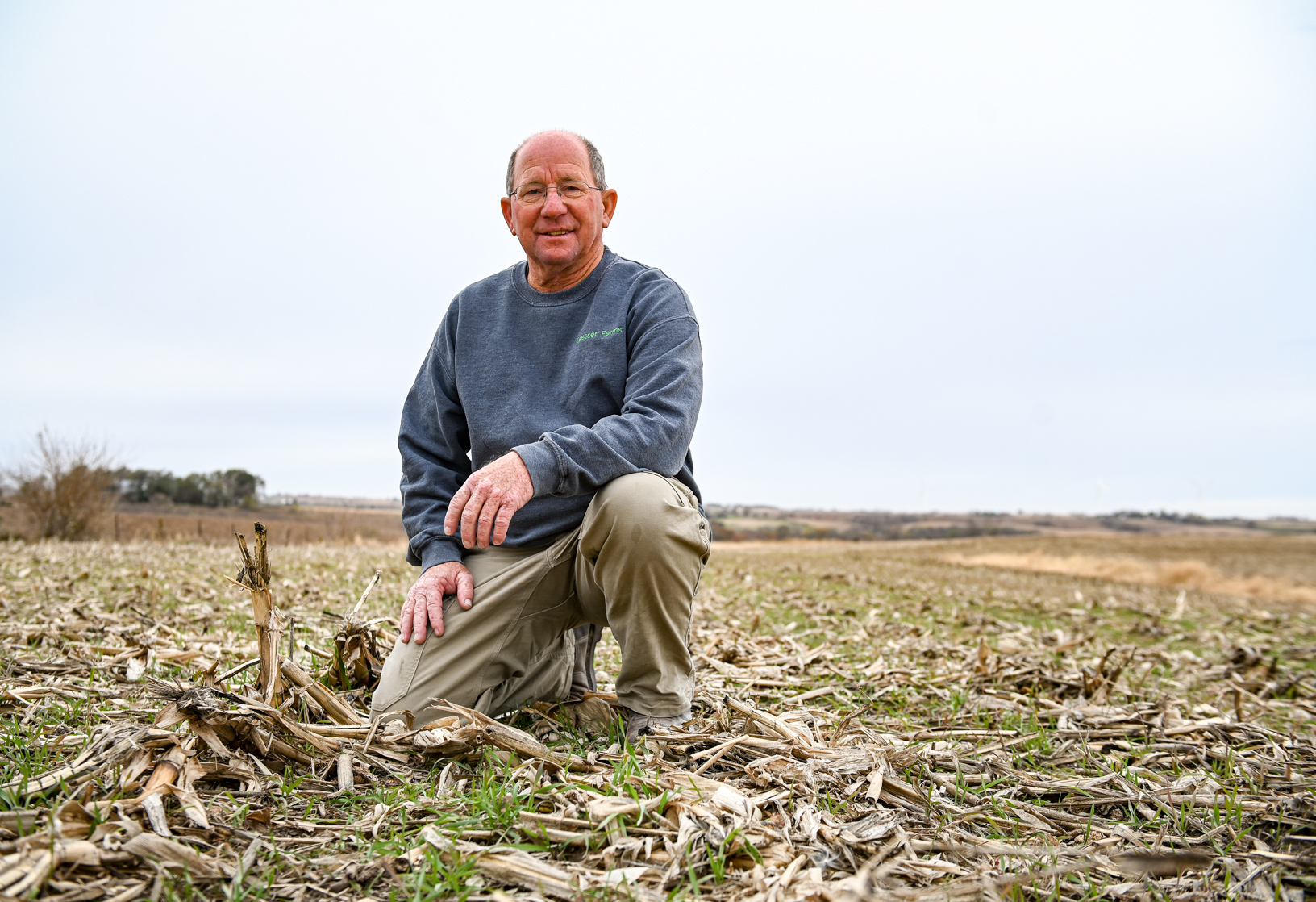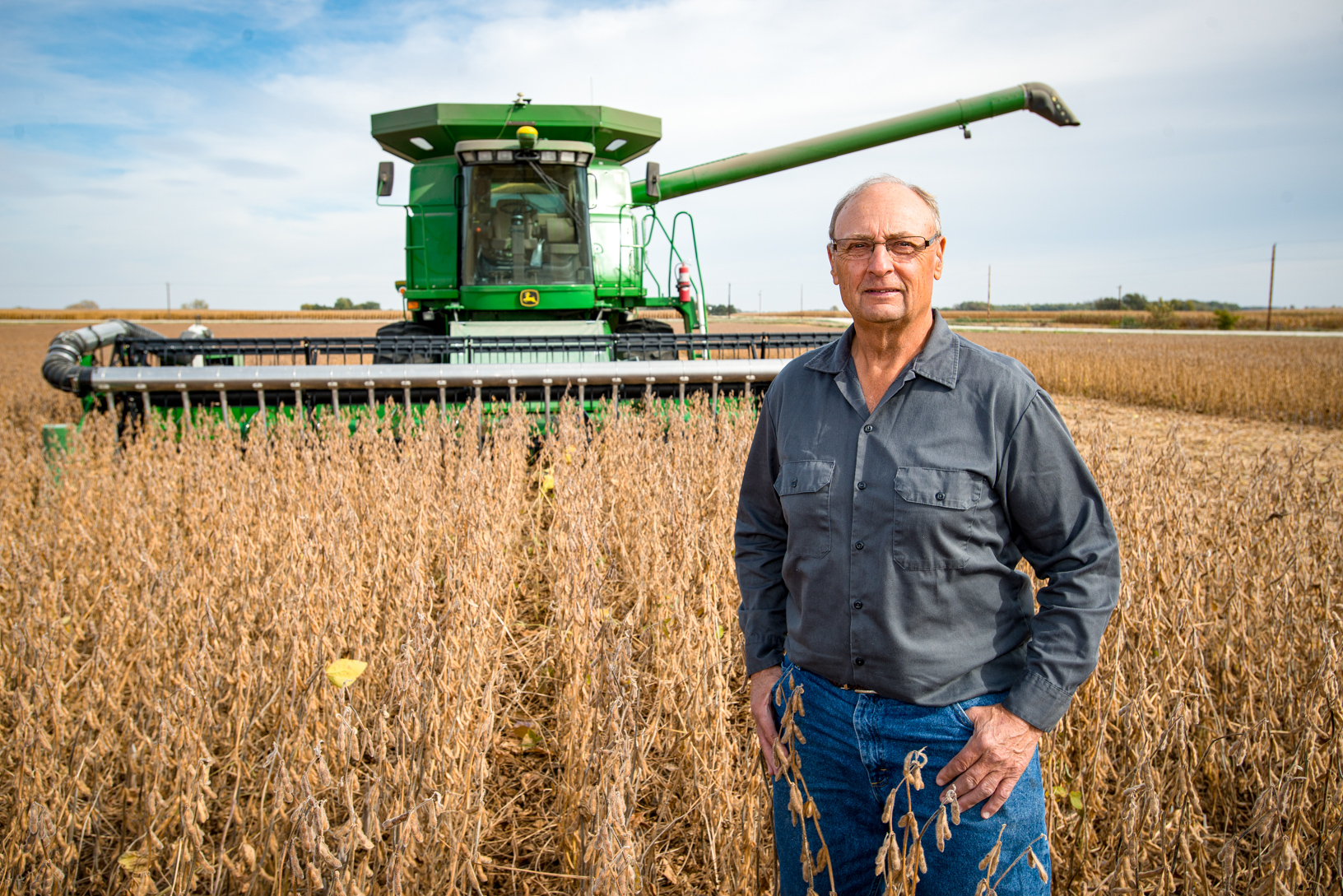
ISA Past President Ray Gaesser says preserving and growing his family's conservation efforts are a piece of his family's transition plan. (Photo: Joseph L. Murphy//Iowa Soybean Association)
How farm transition plans can preserve conservation values and legacies
April 23, 2020 | Bethany Baratta
A significant number of farmland acres in Iowa will be transferred to the next generation of farmers in the coming decade, providing a great opportunity for preserving and expanding conservation practices that have proven financial and resilience benefits.
According to Iowa State University, 60% of Iowa farmland is owned by people over the age of 65, and 35% of Iowa farmland is owned by those over 75. By 2024, landlords in the United States expect to transfer 91.5 million acres, or 10% of all U.S. farmland.
The way in which the land is transferred from one generation to the next could have a profound impact on the future of conservation efforts, and of the land itself.
Having a farm transition plan that includes conservation not only ensures the continuation of the farm – it also helps preserve a farmer’s conservation legacy. Here’s how two Iowa farmers are navigating their planning to ensure their conservation legacies endure.
One farmer’s “aha” moment
“We are all committed to trying new practices that make soil better and protect our water,” says farmer Ray Gaesser of Corning, Iowa. “And we need to have a plan for how we can continue those efforts when we step away from the farm.”
Ray and his wife Elaine are currently working through their formalized transition plan with their son, Chris, and his wife, Shannon, who are partners in their row crop business.
The Gaessers have built terraces and grassed waterways. Ray implemented no-till 30 years ago. He’s a believer in using technology and participating in research trials with the Iowa Soybean Association and other organizations to seek ways to farm more productively.
Chris recalls the moment when he and his parents watched four inches of rain fall in one hours’ time, washing away crop residue that had built up over decades. The painful event prompted them to increase their conservation efforts.
“Even though we were doing something already, it wasn’t enough, and we knew we had to do better,” Chris says.
The family planted cereal rye as a cover crop to help stabilize their soil and build soil health. Currently, the Gaessers have about 65% of their acres covered in cover crops. They see their dedication to conservation as a perfect complement to their transition plan, which sets up the continuation of the family’s commitments.
“We have a responsibility to transition and help the next generation,” Ray says. “We also have to be able to learn to let go and let them make some of those decisions. As we learn that, we need to keep the value and the business model intact.”
How to pass conservation commitments on to the next generation
David Baker is the director and a farm transition specialist with Iowa State University’s Beginning Farmer Center.
“There shouldn’t be anything holding farmers back from continuing conservation practices,” Baker says. “If anything, it’s lack of knowledge and experience. That’s where the older generation comes into play.”
Baker says mentorship, coupled with financial assistance programs for conservation practices, will help grow conservation efforts in the state. He’s worked with several farmers to determine the best ways to include conservation in contracts and agreements with their heirs and non-heir tenants and operators.
Since 2016, when Baker transitioned off the farm, he’s worked with his non-heir farm tenant to explain different programs in place to help farmers continue and grow their conservation practices. USDA programs such as the Conservation Stewardship Program (CSP), Environmental Quality Incentives Program (EQIP), and the Conservation Reserve Program (CRP) can help to support conservation practices.
Baker also directs farmers to resources within Iowa State University’s Water Quality Program and the Water Rocks Program to think about edge-of-field structures and practices and in-field management practices which could be added to a farm’s list of practices. His tenants sought the help of the Beginning Farmer Center and the beginning farmer tax credit to get their start in livestock and crop production. Another resource through the Beginning Farmer Center is the Ag Link Matching Program, which helps connect non-related parties for the transitioning of a farm business.

ISA Past President Wayne Fredericks says farmland values ought to reflect the value of increased organic matter and soil health. (Photo: Joseph L. Murphy/Iowa Soybean Association)
Planning to mentor the next generation of farmers
Well known for his conservation efforts, Mitchell County farmer Wayne Fredericks and his wife Ruth have one daughter who lives in Texas with her family. Wayne hasn’t identified an heir who will take over the farming operation when he retires.
“We will definitely write a conservation lease,” says Wayne, who farms near Osage. “In there, we will have the goal on what we want to happen in terms of tillage practices and conservation efforts.”
The Fredericks raise soybeans and corn in a 50-50 rotation and have been long-time users of no-till and strip-till. They have spent many years working on trials with ISA and have implemented cover crops on nearly all of their acres. They have installed grassed waterways, buffer strips and have implemented other practices which build soil health and protect natural resources. Wayne also has some land set aside as a pollinator habitat.
Though he doesn’t have a transition plan formalized for his land, he expects to reach out to younger farmers showing progress and promise in continuing his conservation legacy.
“I’m in a pretty fortunate area here because our younger farmers are more progressive than our old farmers when it comes to conservation,” he says. “My goal is to transition my acres to maybe one, two or three young farmers who are either already strip-tilling, no-tilling or transitioning to that point.”
“There’s some real value” in conservation inheritance
Wayne says conservation practices and improved soil health ought to be figured into farmland values, much like Corn Suitability Ratings are for farms in Iowa.
“When you really sit down and put value on soil carbon and what the inherited value of that organic matter is to the soil, there’s some real value there,” Wayne says.
Through Wayne’s soil testing, he’s calculated a 2.5% increase in organic matter on three different farms over the past 25 years. According to the Value of Soil Health publication from the NRCS, for every percent increase in soil organic matter, an additional 16,500 gallons of water is available in the soil. Using an average commodity price from 2009 through 2013 for corn and soybeans this would equate to $18 per acre income, per 1 percent increase in organic matter, according to the NRCS.
Soil organic matter is a significant source of nutrients. An acre of a medium textured soil profile, approximately six inches deep, will weigh approximately 2 million pounds. At an average mineralization rate of 1.5%, this could account for up to 17 pounds of nitrogen and 1.75 pounds of phosphorus per percent of organic matter, according to the NRCS. At current prices of commercial fertilizer, this would amount to approximately $11 per percent of organic matter. Using 1% soil organic matter as a baseline level, the total long-term value of a 1% increase is an estimated $29 per acre for the nutrient value and available water holding capacity.
The $29 per acre nutrient benefit at a 2.5% increase in 25 years means increased benefits to soil health, which Wayne says ought to be accounted for.
“My field should be more productive than the farmer across the field that has the same soil and does full-width tillage,” Wayne says. He added that incentives like reduced crop insurance rates should be provided for more productive acres with increased soil health scores, since they reduce risk potential.
New programs like the Soil and Water Outcomes Fund are positioned to provide financial incentives to farmers and landowners to implement agricultural best management practices and monetize the resulting environmental benefits by selling verified outcomes to the beneficiaries. The Fund helps elevate the incentives and opportunities to grow conservation practices in the state.
Whether carried on through contracts or mentorships, farmers like Ray Gaesser and Wayne Fredericks are demonstrating why conservation legacies are worth preserving, contributing to both a personal sense of fulfillment, and in setting the next generation of farmers on a better, more resilient course for the future.
Back